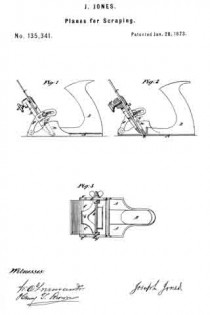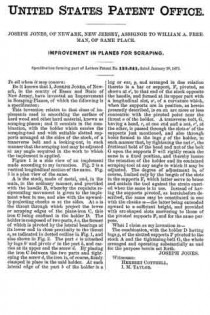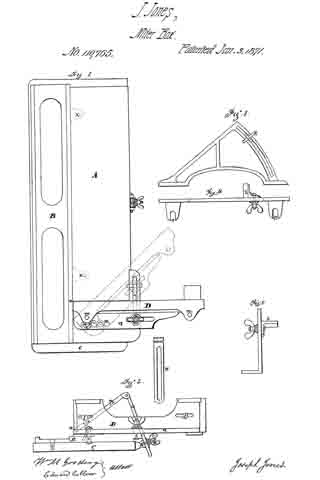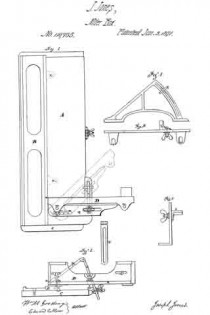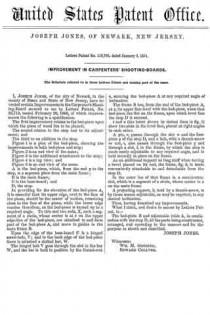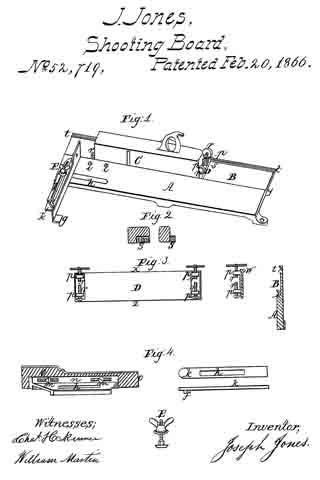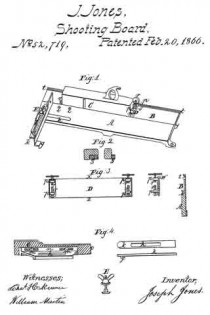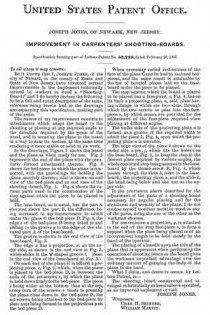No. 135,341 – Improvement In Planes For Scraping (Joseph Jones) (1873)
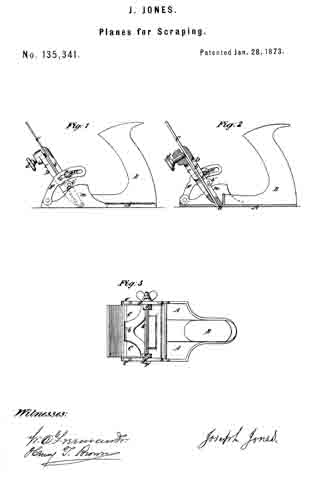
UNITED STATES PATENT OFFICE.
_________________
JOSEPH JONES, OF NEWARK, NEW JERSEY, ASSIGNOR TO
WILLIAM A. FREEMAN, OF SAME PLACE.
IMPROVEMENT IN PLANES FOR SCRAPING.
_________________
Specification forming part of Letters Patent No. 135,341, dated January 28, 1873.
_________________
To all whom it may concern:
Be it known that I, JOSEPH JONES, of Newark, in the county of Essex and State of New Jersey, have invented an Improvement in Scraping-Planes, of Which the following is a specification:
This invention relates to that class of implements used in smoothing the surface of hard wood and other hard material, known as scraping-planes; and it consists in the combination, with the holder which carries the scraping-tool and with suitable slotted supports arranged at the sides of the stock, of a transverse bolt and a locking-nut, in such manner that the scraping-tool may be adjusted at any angle required in the work to which the implement is applied.
Figure 1 is a side view of an implement made according to my invention. Fig. 2 is a vertical longitudinal section of the same. Fig. 3 is a plan view of the same.
A is the stock, made of metal, and, in the main, in the ordinary manner, and provided with the handle B, whereby the requisite reciprocating movement is given to the implement when in use, and also with the upwardly-projecting cheeks m at the sides. At a, is the throat through which project the lower or scraping edges of the plane-iron C, this iron C being confined in the holder D. The holder is composed of two parts, b c, the former of which is pivoted by the lateral bearings at its lower end in close proximity to the throat a, as indicated in dotted outline in Fig. 1, and also shown in Fig. 2. The part c is attached by lugs b’ and pivots c’ to the part b, and carries at its upper end the screw d. By placing the iron C between the two parts and tightening the screw d, the iron is, of course, firmly clamped in place in the said holder. At each lateral edge of the part b of the holder is a lug or ear, g, and arranged in due relation thereto is a bar or support, F, pivoted, as shown at e’, to that end of the stock opposite the handle, and formed at its upper part with a longitudinal slot, a’, of a curvature which, when the supports are in position, as herein presently described, is on an arc more or less concentric with the pivoted point near the throat a of the holder. A transverse bolt, G, having a head, r, at one end and a nut, r’, at the other, is passed through the slots a’ of the supports just mentioned, and also through holes formed in the lugs g of the holder, in such manner that, by tightening the nut r’, the frictional hold of the head and nut of the bolt G upon the supports F will rigidly retain the same in a fixed position, and thereby insure the retention of the holder and its contained scraping-tool at any angle to which it may be adjusted. The degree of adjustment is, of course, limited only by the length of the slots in the supports F, Which latter serve to brace and sustain the tool against the strain exerted when the same is in use. Instead of having the supports pivoted, as hereinbefore described, the same may be constituted in one with the cheeks m — the latter being extended upvvard to a sufficient height, and provided With arc-shaped slots answering to those of the pivoted supports F, and for the same purpose.
What I claim as my invention is —
The combination, With the holder D having lugs g, of the slotted supports F pivoted to the stock A and the tightening-bolt G, the whole arranged and operating substantially as and for the purpose herein set forth.
JOSEPH JONES.
Witnesses:
HERBERT COTTRELL,
I. M. TAYLOR.

